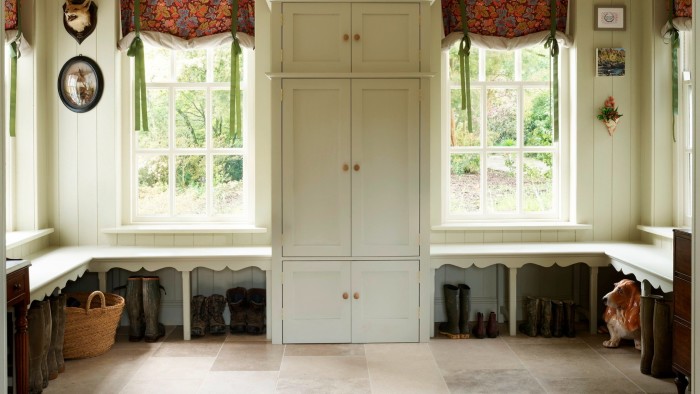Unlock the Editor’s Digest for free
Roula Khalaf, Editor of the FT, selects her favourite stories in this weekly newsletter.
It’s not glamorous, but a boot room would be the first thing I’d put in my fantasy home: a liminal space to leave the outside world’s detritus behind (scooters, tote bags, wet umbrellas, muddy running shoes) before serenely entering a clutter-free house.
I’m not alone. “One of the greatest modern luxuries is space, especially space that keeps the practical utilitarian elements from seeping into the kitchen, bathroom or hallways,” says Steven Rodel, creative director at design studio Guy Goodfellow. “They provide a buffer.”
English in origin, it is the Americans who have “created a trend for a tailored and more decorative boot room”, says Nicole Salvesen, co-founder of interior design studio Salvesen Graham, which is frequently commissioned to create upscale interpretations. The modern boot room is an “invested-in room that gets as much focus as the kitchen, rather than a room that is purely functional with not much budget spent on it”. She currently has projects with boot rooms in Colorado’s Rocky Mountains, Cornwall and Surrey.
For a listed Georgian house in Gloucestershire, interior design studio Artichoke is constructing a fully panelled boot room with an open fireplace and a sink carved from a single block of stone, weighing a quarter of a tonne. The idea is to create a room “that looks like [it has] always been there and will last for centuries to come”, says Bruce Hodgson, founder and creative director. “Traditionally, sinks would have been made from a single piece of stone and this is one of the reasons why we love using them — as well as their solidity, character and longevity.”
But the modern boot room is not, of course, just for boots. It now also plays host to a number of ancillary utilities, from washing machines to flower-arranging sinks and even dog showers, according to Salvesen. “Almost anything that makes life easier, tidier and more practical can be worked in,” Rodel says. Designs all depend on the number of children, animals and hobbies a client has.
Alongside shoe storage and somewhere to hang coats, there are typically shelves and drawers — then it’s time to consider “very bespoke storage to accommodate the different types of equipment that a client might need”, says Salvesen. Taking note of any particular sports kit, like for riding or fishing, that needs to be stored, this could be built-in cabinetry or antique pieces — it doesn’t have to be boring.
The cleverest storage designs feature practical solutions to deal with wet clothes. Artichoke often installs radiators beneath stone benches and coat pegs. In her own Swedish farmhouse, designer Beata Heuman has an old wooden settle with a lift-up lid that fits over the radiator. Inside she has installed chicken wire “shelves” to put wet boots on to dry. Rodel likes baskets and boxes underneath benches to “help corral umbrellas and dirty boots without feeling cluttered or chaotic”.
A hard-wearing — often stone or tiled — floor is a necessity. Heuman has Höganäs ceramic tiles. Hodgson says he favours durable natural stone, which is “traditional to country houses”. Artichoke often adds a drain into the floor, and zinc plinths to provide a buffer between the floor and wall panelling to prevent scuffing from mopping.
Panelling, meanwhile “can take some knocks and be wiped down, unlike a painted wall”, Heuman says. Rodel advises including seating for putting on or removing shoes, “particularly for the very young or very old.”
Adding elements of beauty and fun can elevate the functional. Some homeowners are opting for bright wallpaper and floral upholstery, or joinery in rich reds, yellows and blues in lieu of practical mud tones. For Heuman, it’s a bench that she reupholstered in silk velvet left over from another project. “I like having things fine and luxurious in a rough spot. It shouldn’t be there, and I love it for that reason.” An elaborate light fixture — “they are up and out of the way” — could be a less risky addition, she says. She also bought matching vintage Swedish coat racks to hang either side of the 18th-century interior doors.
And for those for whom a boot room just isn’t enough, consider this. In a Regency country house in Hampshire, Artichoke recently added a second derobing room: a slipper room. If only I had the space.
Find out about our latest stories first — follow @ft_houseandhome on Instagram
Read the full article here

